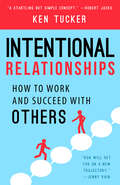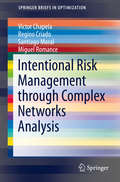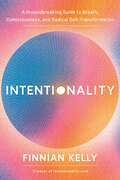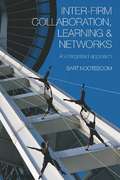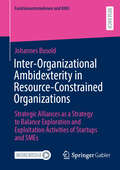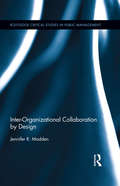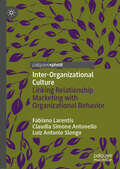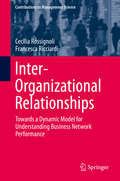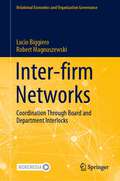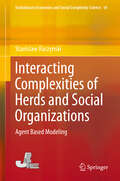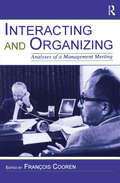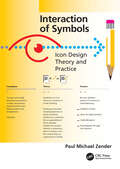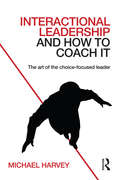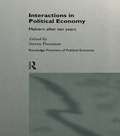- Table View
- List View
Intentional Power: The 6 Essential Leadership Skills for Triple Bottom Line Impact
by Lisen Stromberg JeanAnn Nichols Corey JonesIntentional Power: The 6 Essential Leadership Skills for Triple Bottom Line Impact is THE playbook for modern leaders. Intentional Power: The 6 Essential Leadership Skills for Triple Bottom Line Impact explores how the transition from shareholder capitalism to stakeholder capitalism has created an urgent need for a new model of leadership; a model that enables leaders to navigate competing demands from both internal and external stakeholders including the most racially and age-diverse workforce in history, activist investors, purpose-driven customers, and global government regulators. Intentional Power argues persuasively for a more inclusive, comprehensive approach to leadership disrupting the conventional approach that has been taught for decades in business books, management courses, and by traditional leaders themselves. It is a guide for delivering triple bottom-line impact: enhancing profits, people, and the planet. Written by Lisen Stromberg, JeanAnn Nichols, and Corey Jones, three leadership experts who bring a wealth of experience from their decades of working within companies and alongside leaders as advisors, coaches, and corporate consultants, Intentional Power is a call to action for the next generation of leaders to move beyond an entirely individual focus toward a more sustainable approach to lead and succeed. Deeply researched, the authors draw on an extensive review of the latest literature and insights on leadership development, cognitive and positive psychology, organizational design, and performance management, as well as extensive interviews with leaders across several industries to highlight the most critical skills required by today's executives and managers. They offer a new model of leadership, the HEARTI® model, built on six core competencies: Humility, Empathy, Accountability, Resiliency, Transparency, and Inclusivity. These 6 leadership skills are essential for success in today's new world of work. You'll also find: A comprehensive, inclusive, and effective approach to leading organizations through the rest of the 21st century Examples from leaders across numerous industries who are driving impact for the teams, the companies, and the world at large Practical "How-To's" and actionable Leader Tool Kit activities to help you learn and apply the skills discussed in the book An essential and exciting new resource for next-generation and practicing leaders ready to create profitable companies full of meaning and purpose, Intentional Power is the hands-on leadership guide that founders, entrepreneurs, directors, executives, managers, and impact-driven employees everywhere have been waiting for.
Intentional Relationships: How to Work and Succeed with Others
by Ken TuckerEvery day, our actions are structured by our relationships. Whether it be through family ties, a shared workspace, a favorite hobby, or some other repeated interaction, we are constantly building relationships. But do we ever stop to consider why we are in a relationship with a particular person? How can we make important relationships stronger? And how can we avoid unhealthy relationships? From Fortune 500 consultant Ken Tucker, Intentional Relationships answers these questions and more in a surprising, life-changing, and career-enhancing way. Recognize and celebrate the most valuable connections in your life by practicing Intentional Relationships.
Intentional Risk Management through Complex Networks Analysis
by Victor Chapela Regino Criado Santiago Moral Miguel RomanceThis book combines game theory and complex networks to examine intentional technological risk through modeling. As information security risks are in constant evolution, the methodologies and tools to manage them must evolve to an ever-changing environment. A formal global methodology is explained in this book, which is able to analyze risks in cyber security based on complex network models and ideas extracted from the Nash equilibrium. A risk management methodology for IT critical infrastructures is introduced which provides guidance and analysis on decision making models and real situations. This model manages the risk of succumbing to a digital attack and assesses an attack from the following three variables: income obtained, expense needed to carry out an attack, and the potential consequences for an attack. Graduate students and researchers interested in cyber security, complex network applications and intentional risk will find this book useful as it is filled with a number of models, methodologies and innovative examples.
Intentionality: A Groundbreaking Guide to Breath, Consciousness, and Radical Self-Transformation
by Finnian KellyDiscover the transformative power of Intentionality—a feelings-first approach to living and leadershipDo you want to fully reconnect with yourself and reclaim your power?To unlock a world of infinite possibilities, adopt the mantra at the heart of this growing movement—prioritize feelings over outcomes.Using lessons learned from creating and selling multimillion-dollar companies and overcoming upheaval in his own life, Finnian Kelly shares his step-by-step process for manifesting Intentionality into success. Through combining both scientific and spiritual principles, Finnian leads you through the five key intentions, including actionable steps and targeted breathing exercises you can incorporate into your everyday life. Through this process, you will:· Learn the core makeup of your emotional operating system· Let go of social conditioning· Master your built-in superpower of breath· Recode your mind· Elevate your consciousnessIntentionality is more than just a concept—it's a profound shift in consciousness that will enable you to truly feel and experience more of what life has to offer.
Intentioning: Sex, Power, Pandemics, and How Women Will Take The Lead for (Everyone's) Good
by Gloria FeldtIntentioning by best-selling author Gloria Feldt will help you envision the life and career you might have thought were impossible dreams, then give you the courage and actionable tools to achieve them. In the wake of the coronavirus pandemic and a pandemic of racial injustice that together shook our world to its core and revealed deep fault lines in our culture, Gloria Feldt, New York Times best-selling author, speaker, commentator, international leadership expert, successful CEO, and feminist icon, shows how we can seize the once-in-a-lifetime opportunity created by massive disruption to build back stronger with diverse women at the center of the recovery. In Intentioning: Sex, Power, Pandemics, and How Women Will Take The Lead for (Everyone&’s) Good, Feldt inspires diverse women to embrace their personal power to lead with intention, confidence, and joy. It comes as no surprise to her that women flexed their formidable muscles when needed most, representing a disproportionate number of essential workers during the darkest days of the coronavirus global outbreak and leading the charge against racism in the United States. But this book is decidedly about the future, taking the leadership lessons learned from this disruption and creating a better world for all. Feldt not only unveils the next step in advancing gender parity in all spheres of business and life, but she also lays out the vital next steps in the overall advancement of our economy and our civilization. The &“Lead Like a Woman&” framework and the &“9 Leadership Intentioning Tools&” she presents in this book will prepare, motivate, and propel women of all diversities and intersectionalities now so that by 2025, women will have attained their fair and equal share of leadership positions across all sectors of industry and society. We simply cannot squander women&’s talents when so much hangs in the balance. Women must be at the vanguard of reimagining and reconstructing a vibrant and sustainable future for us all.
Inter and Post-war Tourism in Western Europe, 1916–1960 (Palgrave Studies in Economic History)
by Carmelo Pellejero Martínez Marta Luque ArandaThis edited collection is a novel book with contributions from eleven expert researchers on the history of tourism in Europe. This book explores the growth of tourism in contemporary postwar Europe, especially during the periods following the First and Second World Wars and the Spanish Civil War. It reveals both the work carried out by social agents and institutions to develop tourism, and the contribution of tourism in boosting the economy and the recovery of morale in the Old Continent Its origin is the International Congress Postguerres / Aftermaths of War, organized by the Department of History and Archeology of the University of Barcelona, in Barcelona, in June 2019. In this Congress, professors Carmelo Pellejero and Marta Luque coordinated the session Post-war and tourism in contemporary Europe, in which all the authors of the book participated.
Inter-Economy Comparisons: A Comparative Study of Industrial Development, Currency Devaluation, and Inflation
by Leonard A. DoyleThis title is part of UC Press's Voices Revived program, which commemorates University of California Press’s mission to seek out and cultivate the brightest minds and give them voice, reach, and impact. Drawing on a backlist dating to 1893, Voices Revived makes high-quality, peer-reviewed scholarship accessible once again using print-on-demand technology. This title was originally published in 1965.
Inter-Firm Collaboration, Learning and Networks: An Integrated Approach
by Bart NooteboomInter-firm relations are not new. But fast developments in technology and globalization have led to increased opportunities for international alliances, and an upsurge in the interest in inter-organizational relations. With the time ripe for a unified theory of collaboration, Inter-firm Collaboration, Learning and Networks surveys the current field
Inter-Organizational Ambidexterity in Resource-Constrained Organizations: Strategic Alliances as a Strategy to Balance Exploration and Exploitation Activities of Startups and SMEs (Familienunternehmen und KMU)
by Johannes BusoldIn today's dynamic business environment, resource-constrained organizations, such as SMEs and startups, must navigate the dual demands of exploration and exploitation to achieve ambidexterity – a critical capability for business survival and success. This book examines how such organizations can use strategic alliances to benefit from ambidexterity. In an empirical study, 15 case studies of strategic alliances between established organizations and startups are analyzed based on numerous expert interviews with CEOs, founders, and managers. By collaborating, corporates can benefit from the innovative strength of startups, while startups can benefit from the corporates’ networks and reputation. However, these collaborations often prove challenging. The author develops an empirical model that identifies key antecedents of alliance success. This model sheds light on critical elements such as power imbalances and provides actionable insights for fostering effective and mutually beneficial collaboration. This book is essential for entrepreneurs, corporate leaders, and researchers interested in ambidexterity, strategic alliances, and corporate-startup partnerships.
Inter-Organizational Collaboration by Design (Routledge Critical Studies in Public Management)
by Jennifer MaddenAlthough difficult, complicated, and sometimes discouraging, collaboration is recognized as a viable approach for addressing uncertain, complex and wicked problems. Collaborations can attract resources, increase efficiency, and facilitate visions of mutual benefit that can ignite common desires of partners to work across and within sectors. An important question remains: How to enable successful collaboration? Inter-Organizational Collaboration by Design examines how these types of collaborations can overcome barriers to innovate and rejuvenate communities outlining the factors and antecedents that influence successful collaboration. The book proposes a theoretical perspective for collaborators to adopt design science (a solution finding approach utilizing end-user-centered research, prototyping, and collective creativity to strengthen individuals, teams, and organizations), the language of designers, and a design attitude as an empirically informed pathway for better managing the complexities inherent in collaboration. Through an integrated framework, evidence-based tools and strategies for building successful collaboration is articulated where successful collaboration performance facilitates innovation and rejuvenation. This volume will be essential reading for academics, researchers, leaders and managers in nonprofit, private, and government sectors interested in building better collaborations.
Inter-Organizational Culture: Linking Relationship Marketing With Organizational Behavior
by Fabiano Larentis Claudia Simone Antonello Luiz Antonio SlongoIn order to be developed, inter-organizational relationships, as well as organizational cultures, rely on communication, learning, trust, commitment, and shared meanings and symbols. This book discusses the emergence and development of an inter-organizational culture, in which meanings, beliefs, and values of people from different companies interact. It proposes that inter-organizational culture can be seen as a culture of intersection, because of the association of cultural perspectives between suppliers and intermediaries. The more the parties are motivated to maintain the relationship, the more willing they are to invest in that relationship, which minimizes the risk of dissolution, promotes interaction, and contributes to cultural changes. The authors consider organizational culture through a three-perspective framework involving integration, differentiation, and fragmentation, at the intersection of which inter-organizational culture develops. This book will provide scholars with a better understanding of the connection between relationship marketing and organizational behavior, through the emergence of a specific culture.
Inter-Organizational Relationships
by Cecilia Rossignoli Francesca RicciardiThis book explores the premise that organizations are significantly influenced by their inter-organizational relationships; moreover, these relationships may generate important externalities, both positive and negative, impacting the environment at several levels. The advent of the Internet era, on the other hand, has resulted in disruptive changes in traditional inter-organizational networks, and some completely new inter-organizational settings are now arising. In its first part the book reviews the most commonly cited theories explaining inter-organizational phenomena: transaction costs economics, agency theory, resource dependence theory, game theories, collaborative networks theory, institutional theories, organizational ecology, resource-based / relational-based view of the firm, and knowledge network / social network theories. In Part II it thoroughly reviews the literature on a number of key IT-enabled inter-organizational systems currently on the rise, such as virtual organizations, e-intermediators and e-marketplaces. Lastly, Part III presents the case of the Yoox Group, a leading firm offering e-commerce services for fashion and design products. A framework is proposed for systematically linking the different possible types of inter-organizational relationships to specific, suitable sets of theories. The range of possible inter-organizational relationships is described on the basis of three pairs of opposites: conformism-breach, exploitation-exploration, and cooperation-competition. This results in a model that makes it possible to combine different theories in order to study the effects of inter-organizational ambidexterity and dynamism on performance.
Inter-Regional Place Branding
by Sebastian Zenker Björn P. JacobsenThis book examines and clarifies key aspects of regional branding with the special focus of inter-regional brands. Today regions are in strong competition for companies, tourists and most of all talent. In order to differentiate one region from another, regional developers, politicians and planners increasingly focus on establishing the region as a brand. This is by no means easy, since places are complex systems of geographical abstractions in which each place is understood in relation and contrast to other geographical entities. In doing so, regions not only differentiate, but also cooperate (within one country or between countries), building so-called Inter-Regional Brands with an even higher degree of complexity. Accordingly this volume, provides a theoretically well informed but practically oriented overview of this phenomenon - including numerous cases and best practices. As such, it will strongly appeal to both academics and practitioners in the field.
Inter-firm Networks: Coordination Through Board and Department Interlocks (Relational Economics and Organization Governance)
by Lucio Biggiero Robert MagnuszewskiThis book examines the inter-firm networks created by interlock coordination through shared directors (inter-board) and managers (inter-department) at various levels: whole aggregate, core vs. peripheral companies, and distribution by country and sector. Presenting an empirical case study on all the limited liability or stock companies of the aerospace industry in the European Union and its interlock partners worldwide, the authors shed new light on these forms of coordination. Moreover, they reveal the relevance of shared managers’ coordination and hybrid manager-director interlocks.The book applies advanced statistical and social network analysis alike by combining firms’ attributes (e.g. standard economic-financial parameters) and topological indices for firms (e.g. centrality and cluster measures). By conducting the analysis at both the aggregate network level and the cluster or corporate group level, the authors show how extensive and intensive the interlock forms of coordination are, especially when dealing with shared managers. By testing seven hypotheses concerning the research stream on board interlocks and (more broadly) inter-firm networks, the study offers new insights into the role of the financial sector, on the relations between interlock coordination and firms’ performance, on the role of geographical, technological and organizational proximity, and on the relations between interlock coordination and firms’ size. As such, this book will appeal to scholars of organization studies, business and management studies, industrial and evolutionary economics, and economic sociology, as well as officers and policymakers at anti-trust regulation institutions.
Inter: International Terrorism In 1989
by Anat KurzThis annual publication contains statistical data on international terrorism in 1989, as well as brief analyses of key terrorism-related issues. Extensive tables are accompanied by a chronology of significant international terrorist events in 1989 and a glossary of terrorist organizations.
InterGen and the Quezon Power Project: Building Infrastructure in Emerging Markets
by Robert E. KennedyExamines InterGen's breakthrough Quezon power project, located in the Philippines. Explores how InterGen evaluates and manages project risk through partner selection, the use of operating contracts, and project finance techniques.
InterSoft of Argentina (A)
by Linda A. Hill Stacy PalestrantFocuses on InterSoft of Argentina, a growing software company in Argentina. In 1993, InterSoft acquires a Russian software company and Emilo Lopez, the vice president and director of InterSoft's Systems Software Lab, must manage a creative, cross-cultural, "virtual" team. This case illustrates InterSoft's origins and highlights the relationship between the founding partners, Lopez and Felix Racca.
InterSoft of Argentina (B)
by Linda A. Hill Stacy PalestrantFocuses on InterSoft of Argentina, a growing software company in Argentina. In 1993, InterSoft acquires a Russian software company and Emilo Lopez, the vice president and director of InterSoft's Systems Software Lab, must manage a creative, cross-cultural, "virtual" team. This case reveals a quarrel that arises over e-mail between an Argentine programmer and a Russian programmer. Lopez, as the manager of the development team, must decide how to handle the situation. Since the exchanges between these programmers were preserved in e-mail files, this case provides a unique opportunity to analyze a conflict situation as it escalates.
Interacting Complexities of Herds and Social Organizations: Agent Based Modeling (Evolutionary Economics and Social Complexity Science #19)
by Stanislaw RaczynskiThis book presents examples of and the latest simulation studies on artificial societies and populations, highlighting innovative implementations of various models of artificial societies and populations using a new, C++-related simulation tool. It demonstrates that the prey-predator models—including spatial distribution, moving patterns, limited renewable food, fear, gregarious (herd) instinct, clustering, epidemics, and competition—are more complex than other publications have suggested, and highlights the great discrepancy between agent-based and conventional continuous models. The book also discusses the modeling and simulation of self-organization and interactions between organizations, including terror organizations, offering fascinating insights into organizational dynamics. The book provides a broad range of examples and comparisons with the classical dynamics approach, showing readers how to construct models of complex systems. It starts with descriptions of the behavior of interacting individuals and also includes important information on the macro-behavior of the whole system.
Interacting and Organizing: Analyses of a Management Meeting (Routledge Communication Series)
by François CoorenThis work provides an exceptional case study, shedding light onto the functioning of an actual corporate board of directors. It presents analysis of a series of corporate management meetings shown in the 1974 documentary film, Corporation: After Mr. Sam. The film chronicles the discussion and communication processes as a company considers how to replace its president, and it serves as a unique opportunity for analysis of real-world organizational discourse. With an impressive list of prominent contributors, Interacting and Organizing: Analyses of a Management Meeting employs the dual perspectives of organizational communication and language and social interaction (LSI) to examine the film. It is arranged around specific topics, analyzed separately by organizational communication and LSI scholars. Editor François Cooren provides an introduction for each topic, and a comparison and synthesis conclude each part. Readers will appreciate the information presented, as it is an arena typically off-limits to outside eyes. The transcript of the film is included as an appendix to the volume. This volume is appropriate for use in advanced courses and seminars in organizational communication, LSI, management, and organizational behavior. With its distinctive approach to studying the film's content, it will be invaluable to scholars, researchers, and graduate students in organizational communication, LSI, and management.
Interaction for Designers: How To Make Things People Love
by Brian L.M BoylInteraction for Designers shows you how to connect a product with its users, whether it’s a simple toaster, a complex ecosystem of intelligent devices, or a single app on your smartphone. This book covers the entire design process so you can start with an idea and carry it through to an engaging final design. It carefully leads you step by step and richly illustrates each stage with examples drawn from business communication, social media and the social economy, consumer electronics, architecture and environments, health care, psychology, art and culture, education, athletics, automotive design, entertainment, fashion, the family home, and a wealth of others. You’ll learn how to brainstorm ideas, research them, explore them, evolve them into finished designs, pitch them, all with the goal of helping you make things that people love. Includes over 200 color images, a glossary, and links to web resources highlighting design concepts and designer interviews. http://interactionfordesigners.com/
Interaction of Symbols: Icon Design Theory and Practice
by Mike ZenderInteraction of Symbols is a book for everyone engaged with icon design. It presents a theory of how icons work: symbols in an icon interact to evoke meaning. From this theory flow design principles and practices based on evidence from Design and other disciplines such as Psychology, Perception, and Cognition. The theory, principles, and practices impact how all symbol-based communications are conceived, designed, and applied.The book focuses on icons that elicit a concept without any previous training or use of language. Findings from twenty years’ worth of empirical design research studies explore, illustrate, and support each principle, process, and recommendation. The book begins with a review of icon research from various fields before laying a conceptual foundation that grounds the theory of the book. After and elaborating on that theory are chapters that demonstrate how to Establish Contexts to Guide Comprehension, Glean Which Symbols to Draw, Learn How to Draw Understandable Symbols, Clarify Metaphor, and Use Icons to Decipher Icons in Icon Systems. Written and carefully designed for a broad audience, the book’s scholarly level is elevated while the presentation is approachable. Scholar or professional can skim, scan, or dig, it’s up to them.Heavily illustrated and supported with ample citations, it is not only a book for students and professionals within the field of communication design, but also for anyone who communicates with visual symbols, from healthcare professionals to software engineers, affecting all kinds of graphic communications from advertisements to assembly instructions.
Interactional Leadership and How to Coach It: The art of the choice-focused leader
by Michael HarveyAll leaders make choices, but not all leaders are choice-focused. In Interactional Leadership and How to Coach It: The art of the choice-focused leader Michael Harvey presents an important new theory of leadership which demonstrates how to coach successful choice-making. This clear, wide-ranging book integrates business and psychology, exploring the art of choice-focused leadership through neuroscience, cognitive psychology, existential philosophy and leadership studies. Interactional leadership helps leaders to make informed decisions throughout the "achievement cycle" of strategy, resourcing and delivery, and emphasises the importance of psychological balance. The book features chapter-long case studies which provide unique insights into the leader’s inner world and clearly illustrate how the tightrope of leadership can be mastered. Harvey draws important lessons about decision-making from corporate leaders, politicians and even Shakespeare’s tragic heroes, and addresses the leader’s ethical responsibility for major issues facing us now and in the future. The interactional model also focuses on coaching the multiple roles of leadership, such as global leader, team leader, innovator, entrepreneur and chair of the board. Accessible and practical, Interactional Leadership and How to Coach It is an ideal guide for coaches, leaders, students, trainers of coaches and anyone involved in leadership development and recruitment.
Interactions in Analytical Political Economy: Theory, Policy, and Applications
by Mark SetterfieldIn this interactive collection of essays, many of the leading proponents of analytical political economy examine major macroeconomic issues through the integration of mathematical analysis and non-neoclassical economic theory. The topics covered include the macroeconomics of the labor market, open economy issues, economic growth, and macroeconomic policy. The chapter-comment-reply format of the book creates a genuine dialogue on each theme, and evokes a sense of unfolding debate which draws the reader into the discussion.
Interactions in Political Economy: Malvern After Ten Years (Routledge Frontiers Of Political Economy Ser. #No.3)
by Steven PressmanIn recent years there has been a growing dissatisfaction with standard economic theorising which has fostered the development of alternative ways of understanding how economies actually work. Too often though these approaches have been developed in isolation, or even in opposition to each other. However, Interactions in Political Economy, demonstra

